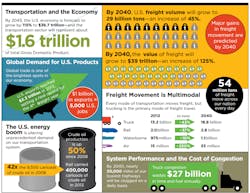DOT looks into the future to set 'rules of the road' for modern freight system
As the White House rolled out a half-trillion dollar, six-year transportation plan earlier this week, Transportation Sec. Anthony Foxx was rolling into the heart of Silicon Valley in a self-driving car.
Foxx was the guest of Google Executive Chairman Eric Schmidt at a “virtual townhall” to introduce the DOT’s long-term look into the future, Beyond Traffic 2045.
As Foxx laid out the current state of planning and funding the nation’s transportation system, Schmidt and the audience at Google headquarters in Mountain View, CA seemed stunned when Foxx reported 32 short-term extensions to federal transportation spending plans over the past six years.
“What’s wrong here?” Schmidt said. “Do we not care about infrastructure anymore?”
Foxx, in his explanation, was careful not to assign blame. It's the process, not necessarily the politics, that's the problem.
“In my talks with members of Congress, on a bipartisan basis people realize that we’ve got to do something – but it is a question of what that something is,” Foxx said. “That is why this framework is so important.”
The transportation system has been “riding on cruise control” since the federal highway system was completed decades ago, and Foxx dated the air traffic control system to World War II. Yet the nation has changed substantially, in terms of both demographics and the way Americans live and work, he explained.
“The debates we have about funding are trying to get to last year’s funding, as opposed to looking out through a longer window and working your way backwards toward result-oriented investments,” Foxx said. “The will is still there. Folks stuck in traffic right now certainly want a solution. The problem is no one knows what the next thing is.”
And that means that policy makers need to be “at the table” as new technologies are being developed.
For instance, Foxx noted an expected 60% percent increase in truck traffic over the next 30 years – but alternatives are in the works.
“There’s lots of ways that we can attack the problem of how you move freight,” he said. “But we need to figure it out and start creating the rules of the road.”
That big picture includes planning for the impacts of climate change, integrating technology to improve utilization, and “aligning dollars with decision making.”
The problem is that transportation budgets have historically been focused on a dollar amount, rather than on “outcomes,” he repeated.
“What we’re trying to define in this plan are the types of problems that are going to impact the outcome,” Foxx said.
DOT touts Beyond Traffic as “an invitation to the American public” to have a “frank conversation” about the shape, size, and condition of that system and how it will meet the needs and goals of the nation for decades to come.
The program does not advocate for specific policy solutions, DOT says. Instead, it is designed to underscore critical decision points facing the country, by means of analysis, research, expert opinions and public engagement.
DOT offers a “Blue Paper,” which outlines the program, as well a draft framework.
“We’ve got to look at our own regulatory framework to make sure that we’re being as nimble and flexible and adaptive as we possibly can be – because that’s what the future is demanding,” Foxx said. “The fact of the matter is that our transportation system isn’t the old, creaky system that it used to be. It can be very a dynamic, innovative area. But if the regulatory system is too slow and too antiquated, we’re going to lose opportunities to move forward.”
About the Author
Kevin Jones 1
Editor
Kevin has served as editor-in-chief of Trailer/Body Builders magazine since 2017—just the third editor in the magazine’s 60 years. He is also editorial director for Endeavor Business Media’s Commercial Vehicle group, which includes FleetOwner, Bulk Transporter, Refrigerated Transporter, American Trucker, and Fleet Maintenance magazines and websites.

